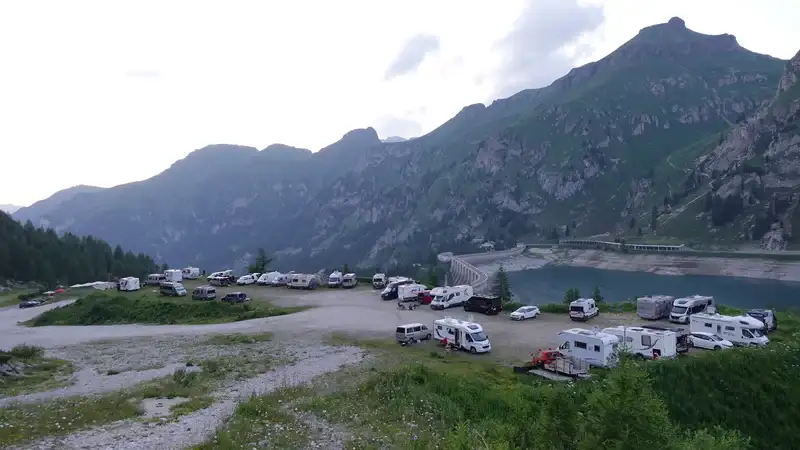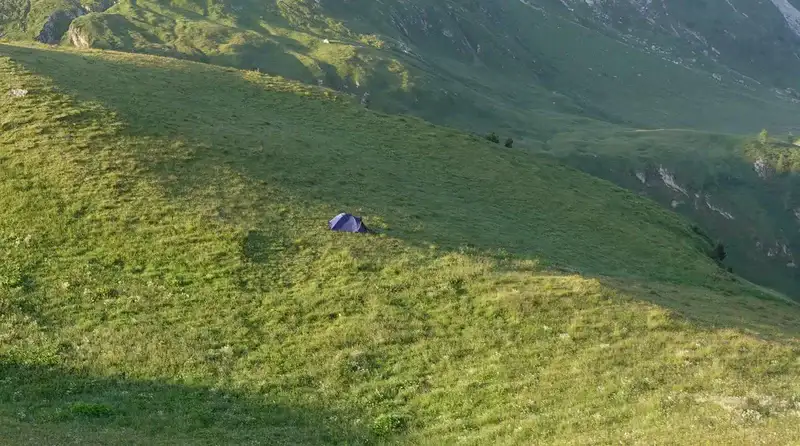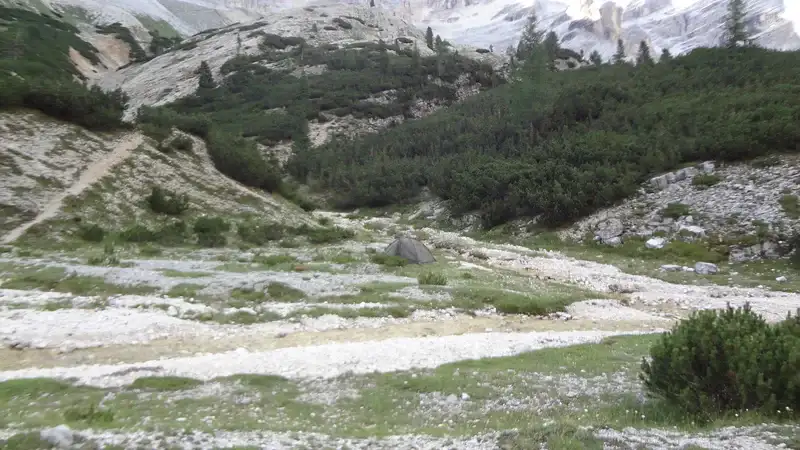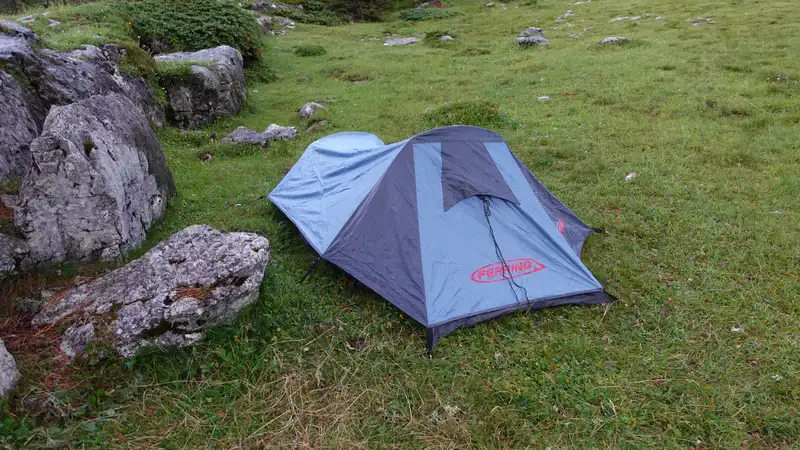The question about camping in the Dolomites is frequently asked on various forums and online groups. Replies from some people are frequently unreliable and detached from reality. Here you have information from official sources.

In some sites, I have seen various unreliable statements like ‘allowed sleeping in the tent above 1500 meters of elevation’, or ‘no problem to pitch the tent from 6 pm till 6 am’.
This all is without any official source given, so it is best to ignore such statements. Besides, such elevations are sometimes within villages so, such a claim is clearly absurd. I even asked ChatGPT and got the following reply:
“There’s a tradition of bivouacking overnight, especially in areas like the Dolomites, but it’s in a legal grey area. Putting up a tent for the night and taking it down in the morning is sometimes accepted by authorities, though leaving a tent pitched for longer periods can result in being asked to move. This practice is more tolerated in less populated or tourist-heavy areas, but it’s still risky, particularly if spotted by patrols or from the air.”
But I would not rely on such a piece of information unless it provides a clear official source. It didn’t, although I asked for it.
Official information about camping in the Dolomites
In the site of Parco Naturale delle Dolomiti d’Ampezzo, I have found this statement:
“Camping either in tents or campers is not allowed. In the valley, in the area before the Park there are camper and camping sites available, while at higher altitudes, bivouacs and mountain rifugi can accommodate visitors for the night.”
As you see, officially you cannot put your tent anywhere, wild camping is strictly forbidden.
In the site of Alpine Guides Cortina, I read the following:
“No, tourist camping is forbidden outside of authorized campsites in the Dolomites. You can only set up camp occasionally and in areas where it is not explicitly banned, with your tent, and not for more than 24 hours.
So you cannot put up your tent in the middle of a forest or riverbank, light a fire, and camp. In the Veneto, article 12 of Regional Law no. 40, dating to 1984, imposes a total ban on camping outside campsites.”
This a bit contradicts the previous source. Also, it is far from clear what they mean with “occasionally”.
I decided to contact some authorities.
♦ Here is what I have received as a reply from a person in charge for Dolomiti Bellunesi National Park, together with their gazzetta ufficiale:
“I can answer about Dolomiti Bellunesi National Park, which is the area under our jurisdiction. In general, however, free camping in Italy is prohibited and camping is allowed only in equipped areas. In some protected areas, in addition to camping, bivouacs are also prohibited.
As regards the protected area Dolomiti Bellunesi National Park, free camping and bivouacs are forbidden (art. 20 of the park regulation); if this rule isn’t observed you must pay a fine from €100 to €1000.
Only temporary overnight stay outdoors are permitted in proved emergencies.”
It is not clear for me what makes the difference and why such a huge fine range. But as you see overnighting should be allowed, assuming that I can understand the meaning of “proved emergency”.
However, if you follow the link given above, the article is on page 33. You will find that there is an extra sentence added (in Italian of course):
“Bivouacs on a wall during mountaineering activities are considered to be an emergency situation.”
It is hard to know which other situations could be understood as emergency. But if you want to play safe and avoid fines, it is best to avoid sleeping in the tent in this part of the Dolomites.
♦ I have contacted four more official institutions from different Dolomites areas, no replies yet. My guess is the outcome would be similar. But if I receive anything from them, this text will be updated.
How is it in reality?
Well, reality is quite different. I know this because I have visited the area many times, and slept in the car on many parkings and high passes in the Dolomites, just like hundreds of other people.
The top picture above shows Fedaia pass, this is not an official parking, just to know, and you have to drive over the dam which is visible in the picture. Now you may realize what I am talking about.
Very similar is at Valparola pass, Falzarego pass, Giau pass, and Tre Croci pass. The same holds for areas between and on Pordoi and Sella passes, there are many places where you can stay in the car overnight.
Every night in summer, literally hundreds of cars, vans, and motorhomes are on these passes, with people sleeping inside. But this should not be understood as invitation to do the same. If you do, then this is your own responsibility.
It is important to know the rules, and you have a bit more about that in my text about sleeping on Dolomites passes.
How about tents?
I have seen tents at many places high in the mountains. If you happen to be early in the morning on any of the Alta Via routes, you will see them yourself. Here is one example:

Here is yet another below. Observe how great the color of this tent is, it cannot be easily spotted by patrols or from the air.

And here is my own Ferrino tent used for overnighting from dusk to down in true sense:

A bit about laws on bivouacking
Bivouacking, or “bivy” for short, generally refers to an emergency overnight stay, typically involving minimal setup like sleeping in a bivy sack or using a small tent for one night only, without the intent of camping in the traditional sense.
Here’s an overview of how bivouacking is treated by laws in various contexts:
General Principles
Emergency use: Bivouacking is often seen as acceptable in emergency situations where hikers or climbers cannot reach a shelter before nightfall due to unforeseen circumstances like bad weather or accidents.
Minimal impact: The key to bivouacking being tolerated is that it should leave no trace. This means no fires, minimal disturbance to the environment, and no littering.
Short duration: Bivouacking is understood to be for one night only, with the setup taken down by morning.
By Country or Region
Italy (Dolomites): In the Dolomites, bivouacking is in a legal grey area. It’s often tolerated for emergencies, but there’s no explicit permission for recreational bivouacking outside of designated camping areas.
The law discourages wild camping, but bivouacking might be overlooked if done discreetly and minimally.
Switzerland: Switzerland has strict camping regulations. Bivouacking above the tree line or in uninhabited high mountain regions might be tolerated for one night, but below these areas, even bivouacking could lead to fines.
France: In France, bivouacking is generally permitted in non-urban areas if it’s done away from roads and leaves no trace. However, certain protected areas might have stricter rules.
Slovenia: Bivouacking or wild camping is not officially permitted in Slovenia. While some sources suggest it might be tolerated in less populated areas or during off-season, it remains illegal. I have seen fines mentioned in some sources, that can go up to €500 for camping outside designated areas, including bivouacking. Particularly strict controls in nature reserves mean bivouacking is less likely to be overlooked here.
Conclusion
So there are laws regarding camping and overnighting in the Dolomites, but clearly, they are not applied very strictly. This is one of the reasons why I love Italy and Italians, and I feel great whenever I visit the country. On the other hand, I love mountains and I feel that laws are not really needed to protect them from me.
To understand better what I am saying, go to Slovenia and see what will happen if you leave the car on a parking during the night, even if you do not sleep there.
I love Slovenia, but I was truly disgusted last summer. Could not leave the car inside the national park on any parking to do planned overnight tours and to sleep in bivouacs on the mountains. I was told that most likely the car would be towed away.
It was so bad that I told myself that I would never again visit the country. But, of course I shall go again, this country used to be a part of my disintegrated homeland, and my fist bigger mountaineering tours took place there.
Back to the Dolomites story, while bivouacking can be legally ambiguous in many areas, the general consensus and practice is that it is tolerated for emergencies with the condition of minimal environmental impact. However, laws can change, and enforcement can vary, so it’s crucial to check. Fines can be very high.
Practical advice if you choose to bivouac or sleep in a tent overnight:
- Do not set up your tent until dark and pack up before sunrise to minimize visibility.
- Avoid popular tourist spots to reduce the chance of enforcement.
- Think about using a tent with a color that blends into environment.
Keep in mind that while some people do this without issue, it’s technically against the law, and the enforcement can vary.
As for sleeping on car parkings in the Dolomites, the reality is that this is the reality, and I hope it will never change. I always claim that the mountains are surprisingly clean in spite of so many people visiting them. This tells something about us who go there, but also about local services and people.
But there are at least 45 official campsites in the Dolomites, so you can make reservations there, and with an app you can have them all at hand.
Thank you for reading. Please join us at our Facebook group Dolomites Visitors Hub.
Subscribe to our weekly newsletter, this will keep you informed because I add texts here regularly. Let me know if you have questions or comments, there is a comment box below. Have a nice day.
Leave a Reply